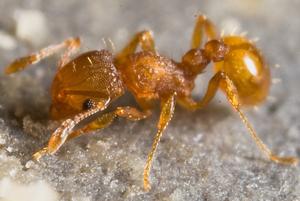 Little fire ants (Wasmannia auropunctata) are now on all four major Hawaiian Islands and they continue to spread in South Kona. Reviewing practices for prevention and control can help keep numbers down and save Kona residences and farms from dangerous infestations.
Little fire ants (Wasmannia auropunctata) are now on all four major Hawaiian Islands and they continue to spread in South Kona. Reviewing practices for prevention and control can help keep numbers down and save Kona residences and farms from dangerous infestations.
We can limit LFAs ability to move from place to place by careful preventative practices. If you see ants that you suspect are LFA, request that the property owner collect and send in samples for positive identification. LFA spread when infested agricultural products, mulch or construction materials are moved to another area. If you send or receive material from areas where you suspect LFA may be present, it is important to test the material before loading or unloading.
The LFA website, littlefireants.com, has an excellent 3-minute video on testing for LFA. It’s easy. You need peanut butter, a chopstick and a plastic zip lock bag. Break a chopstick in half and coat it lightly with peanut butter. Leave it in a moist, shady location for about an hour. If you find ants on the chopstick when you return, put the chopstick and the ants in a zip lock bag while avoiding getting ants on you that might sting. If the ants are red-orange and very tiny, about as long as a penny is thick, they may be LFA. Put the bag in a freezer overnight to kill the ants then prepare it for mailing. Place the bag in an envelope addressed to Hawaii Ant Lab at 16 East Lanikaula Ave., Hilo, HI 96720. Be sure to include contact information for yourself so the lab can get back to you with the results.
If the results are positive you may want to contact the HDOA pest hotline at 643-7878 or the Big Island Invasive Species Committee to make a report and get further advice. The UH publication “Stop the Little Fire Ant” is available online with additional information at ctahr.hawaii.edu/oc/freepubs/pdf/ip-lfa.pdf.
The little fire ant’s ability to nest either in tree tops or leaf litter on the ground and even inside homes makes controlling them difficult. Naalehu recently started a community project to control LFA. They are getting some training and advice on their project from Hawaii Ant Lab, Big Island Invasive Species Committee and the Nature Conservancy. Success is dependent on the dedication and long-term commitment of community members to the project. Since each situation differs slightly, management strategies and products used will vary as advised by the professionals involved.
Some new products are available for use against the ants, but professional advice from the Ant Lab is the best way to determine what will work best in each location. Recently, a “Special Local Needs” label for the product Provaunt was acquired. This allows for it to be used in the Hawaii Ant Lab gel bait recipe, which is now available. Some proportion adjustments were made to the Tango bait recipe for this new product. Provaunt bait kills the ants but is not harmful to humans or animals when used as directed in the Hawaii Ant Lab gel bait. Tango, which has been used extensively here, does not kill the ants but disrupts their reproductive cycle, decreasing population over time. Siesta is a granular bait that is newly available. It works like Amdro but lasts better through wet weather. Tango can be used on edible crops but neither Provaunt nor Siesta is labeled for use on edibles. To be successful at controlling the ants, these products should be used only as directed.
via New information available on little fire ants | West Hawaii Today.
